By Kendra Van Cleave
Originally published on Foundations Revealed: The Corset Maker’s Companion (May 2011).
Throughout the 18th century, fashionable women wore supports under their petticoats in order to create the desired silhouette. Hoops (called “paniers” in French) were rounded early in the century, but soon flattened into an oval shape that extended over the hips. Larger hoops were more popular in the mid-century, as well as for formal wear. However, by the mid- to late-1770s, changing dress styles included a new silhouette for women’s lower half. While hip emphasis remained, there was a new roundness to the silhouette, introducing fullness over the rear. This hip-and-rear silhouette remained in fashion until about 1786-7, when fullness moved to only the rear. In order to create both of these shapes (hip-and-rear and rear-only), women wore pads — called “bums” or “rumps” (in English) and “culs” in French (Ribeiro 222).
According to The History of Underclothes, the rump “…was a large roll pad, tapering at the ends and tied round the waist. It was stuffed with cork or any light cushion stuffing… The revival of this ancient device seems to have appeared, in the fashionable world, early in the 1770’s” (Cunnington 91). In 1776, the Town and Country magazine proclaimed mockingly, “Bum-shops are opened in many parts of Westminster for the sale of cork bums, and report says they go swimmingly on. Tall ladies, and short ladies – fat ladies and lean ladies, must have bums…” (Dec. 1776).
In the 18th century, most of the satirical references and prints focus on rumps made of cork, which seems to have been particularly ridiculous to contemporaries. However, they could also be made of linen or cotton and crin (horsehair). One late 18th century rump (further discussed below) at the Manchester Galleries is made of white linen with padding (the type of padding is not listed) with a silk cover and silk ties. The Boston Museum of Fine Arts has a pair of hip rolls, made of glazed cotton or wool, stuffed with wood shavings and wool tape ties.
Unfortunately, there is little extant evidence as to what shape and proportion these rumps took. Drawing on extant garments, caricatures, and textual references, I created a number of prototype shapes as an experiment to see their effect on the silhouette. By looking at these shapes on two very different body types, we can see which rump shapes work well for the 1770s to mid-1780s, and which work better for the 1780s to 1790s.
Dress Silhouettes, 1770s-1780s
First, let’s examine the desired dress silhouette for this period. Our two main sources for this are portraits and fashion plates. We can assume that most portraits are an attempt to accurately portray an idealized, yet still achievable, silhouette. Fashion plates also attempt to portray an idealized silhouette; however, just as modern fashion sketches make women appear taller and thinner than is generally humanly possible, we must look at 18th century fashion plates with a more critical eye. Indeed, a review of images from the period shows more exaggerated shapes in fashion plates versus those seen in portraits. Nonetheless, both give us an indication of what was the ideal fashionable silhouette.
The key element in silhouette from the waist down was fullness at the hips as well as at the rear until about 1787, after which the focus shifts to fullness solely at the rear. I have tried to select images that I believe do not portray women in side hoops, which were still worn throughout this era for formal wear.
Sources and Reproductions
Drawing on extant garments, satirical prints, and textual references, I created a number of prototype shapes as an experiment to see their effect on the silhouette. Because my focus was on shapes, these are not accurate reproduction garments using historically correct methods and materials. Most are made of cotton muslin or twill, stuffed with polyester fiberfill, cotton batting, or nylon netting. Ties were made of whatever random ribbon or twill tape I could find in my stash. Because they are intended to be mockups only, they were sewn with the fastest, crappiest sewing methods possible.
In order to see how the various shapes would affect different body types, I made small and large versions for two models:
- Sarah Lorraine is our smaller model. She is 4’11”, with a waist of 29” (uncorseted)/27” (corseted) and hips of 37”. The nice thing about working with Sarah on this project is that she is small enough to wear many of the rumps in their original measurements.
- Kendra Van Cleave is our larger model. She is 5’11”, with a waist of 38” (uncorseted)/36” (corseted) and hips of 52”. Her hips are large compared to her frame, so she needs to balance between having enough padding to create the period silhouette… and having too much padding!
Some important notes on the reproduction photographs:
- Sarah has scoliosis, so her corset and hips look off-kilter.
- The mockups made of striped material were made with a remnant piece of fabric on which the stripes were slightly off in printing; do not assume that the stripes indicate grain lines (if you’re the type to peer at that sort of thing).
- In each of the silhouette photographs, the models are wearing the rump, an under-petticoat, and a dress petticoat. The petticoats were not made to be worn over these specific rump shapes, so the hemlines are often wonky.
What follows is a discussion of each source, as well as its reproduction and its resulting effect on silhouette.
1. The Source – Caricature, 1777 (cork- cutter)

One of the earliest sources that I have found for rumps is this satirical print, “Monsieur le Que Ladies Cork-Cutter from Paris Wholesale, Retail, & for Exportation,” from 1777. It shows a shop making and selling rumps; two women are carving cork rumps, while two customers try on the rumps. The shape is strange and interesting, with what appears to be a three-quarter circular shape that is larger and wider on the ends (which would be worn over the hips) and narrower across the middle (which would be worn over the rear).
The difficulty working from caricatures is highlighted here, and we must assume that at a minimum, the artist is over-exaggerating shapes and sizes; furthermore, it is possible that the artist didn’t know what a rump looked like in the first place!
Further complicating things is that the lady trying on a rump in the background is wearing it right up on her waistline. This placement would thicken her waist considerably, and does not look at all like the silhouettes seen in fashion plates and portraits.
The Attempt at Reproduction:
I made a large roll that was supposed to be about three-quarters of a circle. I guessed the proportions right for Sarah’s rump, but Kendra’s turned out to not come forward enough on the hips. The rolls were larger and wider in front versus the center/rear. They were made in cotton, stuffed with polyester fiberfill.
I had difficulty determining where to place them and how to attach them. I decided that because wearing them at the waist would not achieve the desired silhouette, to place them at the high hip. We ended up attaching them with safety pins!
The Resulting Silhouette:
Surprisingly, this shape worked on Sarah! It definitely created a big shape that would work well for the very full 1770s skirts, particularly in the early years when there is still a lot of hip emphasis. It did not work on Kendra for two reasons: the roll did not come forward enough on the hips, and Kendra is already hip-py enough that the shape just looks too big on her.
2. The Source – Doll, 1780
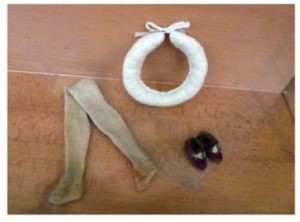
The Victoria & Albert Museum of Childhood holds a wooden doll called “Augusta Marianna,” made in England, 1780. She has her original undergarments, with her outer clothes later additions. Among her undergarments is a rump. However, it is not entirely clear whether the rump is original to 1780. The item description is phrased slightly strangely, “Necklace, stockings, shoes, stays, 3 petticoats, smock, pocket (with handkerchief pincushion and chatelaine), straw hat with doll (also bum roll [rump]); later additions (gown, underskirt, cap, stomacher…).” I believe the rump is original, but question why it is added as a parenthetical addition, so it is possible that it is not.
The Attempt at Reproduction:
A similar shape was made of cotton, stuffed with polyester fiberfill.
The Resulting Silhouette:
This worked well on both bodies for 1770s to mid-1780s. There is a definite added width to the hips as well as the rear. The only negative is that the rear looks more shelf-like than the rounded silhouette seen in many portraits and fashion plates.
3. The Source – Encyclopédie Méthodique, 1785 (rump)
From 1782 to 1832, Charles Panckouke published the Encyclopédie Méthodique, a revised and expanded edition of the Encyclopédie originally edited by Diderot. The entry “Des Paniers pour Ajustemens de Femmes,” in the 1785 volume, describes two items of interest; this is the first.
My rough translation from the French: “The rump is no more than a doubled fabric lined/stuffed(?) in crin [horsehair] between its layers, & quilted with broad squares: it is given half-aune [23.5”] of width, on a third [15”] of height ; it is gathered to the belt, in way that it puffs out behind, & raises the dress…” (Encyclopédie Méthodique, pg. 86).
The Attempt at Reproduction:
It was difficult to work from a solely textual description. I had many questions: what was the shape of the final piece? How broad are “broad squares”? How was it gathered to the belt – equally across its width, or were the gathers focused in particular areas? I had to do a lot of guessing!
In the end, I made the overall shape square, quilted squares of about 3” for Sarah and 5” for Kendra, and (not having any tulle on hand [the modern equivalent to horsehair]) stuffed the squares with polyester fiberfill. I left about 3” without stuffing near the waistband, as seen on many quilted petticoats of the era (otherwise, you are putting quilting right at the waistband, which will thicken the waist). I pleated the rump over the hips, but attached it smooth over the rear.
Sarah’s rump is made to the exact measurements in the Encyclopédie; Kendra’s rump is necessarily larger.
The Resulting Silhouette:
This shape worked well on both bodies, particularly for 1770s to mid-1780s, but could be adapted for a rear-only late 1780s to 1790s shape. It has a nice roundness over the hips and rear, while still maintaining a definite shape. It includes some hip fullness; if it came a bit further forward on the hips, there would be even more. The size of the quilted squares does not appear to matter, nor does the fact that Kendra’s rump is shorter than Sarah’s.
4. The Source – Encyclopédie, 1785 (bouffante for Lévite)

The next item of interest in the Encyclopédie Méthodique is the bouffante for Lévites. The Lévite was a style of dress worn in the late 1770s and 1780s that looks somewhat like a wrapping gown. According to the Encyclopédie, it was worn with a less formal skirt support than the caned paniers that went with more formal gowns.
My rough translation from the French: “The bouffantes for Lévites are not made quilted, but they are stitched & then trimmed [lined?] in crin [horsehair]…; they are without cane nor structure, not worn more than an aune and quarter [58.75”] round, and are tightened in manner that they only cover behind & sides, without returning at all in front; this kind of bouffante is pleated like an underskirt, & cut on half-aune [23.5”] height.”
This garment sounds very similar to the item lying on the floor at the bottom right of this satirical print, “A Pig in a Poke,” from 1786.

The Attempt at Reproduction:
I made a large rectangle using two pieces of cotton twill, and sandwiched about 4 layers of nylon tulle (the modern equivalent of horsehair) in between. This piece extends up to about 3” from the waistband; that top 3” is made of one layer of cotton only, in order to reduce bulk at the waist. I pleated the piece into a waistband.
Sarah’s bouffante is the same dimensions as outlined in the Encyclopédie, while Kendra’s is necessarily larger.
The Resulting Silhouette:
This shape worked well on both bodies for 1770s to mid-1780s. Note that it provides a softer, less dramatic shape than #3 above.
5. The Source – Caricature, 1785 (bum shop)
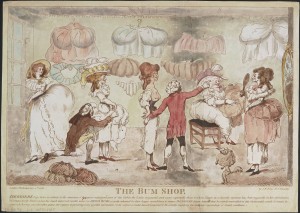
One of the funniest satirical prints featuring rumps is “The Bum Shop” from 1785. The difficulty working from satirical prints is yet again highlighted here, and we must assume that at a minimum, the artist is over- exaggerating shapes and sizes; furthermore, it is possible that the artist didn’t know what a rump looked like in the first place!
The key feature to my eye of the rumps in this print is the fact that they appear to be quilted vertically; wider at the center back than the sides; and they extend over the hips, probably to the front of the pelvic bone. Some of the rumps have a half-length petticoat, which appears to be made of the same fabric, attached underneath the rump.
The Attempt at Reproduction:
I made a large crescent shape, which I quilted vertically into very larger sections, from cotton stuffed with polyester fiberfill. Kendra’s rump has a half-length petticoat, made from pre-quilted cotton/polyester fabric, attached underneath. As I did not find that this made much difference to the silhouette, I opted to leave this off of Sarah’s rump.
The Resulting Silhouette:
This shape worked well for 1770s to mid-1780s in that it incorporates some hip fullness as well as rear. The silhouette looks very similar to #3. Sarah’s could stand to come further forward on the hip, or perhaps be a bit lengthened there, to emphasize her hips more. The shape works well on Kendra, as it merges with her already large hips (but still provides some extra shaping there). The addition of the quilted half-petticoat on Kendra’s did not seem to make a visual difference.
6. The Source – Extant Garments, 18th-early 19th c. (Metropolitan Museum of Art)
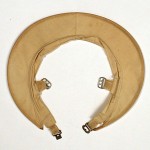
The Metropolitan Museum of Art holds two “bustles,” one dated as 18th century and the other early 19th century. I have never seen anything like these before in image or text, and initially questioned whether the listed dates were incorrect – but the fact that there are two that are close in period seems to indicate that the information is correct.
It is difficult to know how these were supposed to be worn – were they meant to be worn at the hip, causing the dress to flare out around the hips? One bustle has long tapes sewn at the side back, which connect to buckles at the center front (the other has the center front buckles, but no tapes). Perhaps these tapes went over the shoulders to hold the bustle up higher than the waist, in which case perhaps they were meant to be worn at the high Regency waistline, and to hold the skirt out past the narrowing of the waistline?
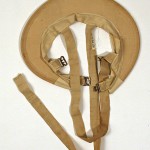
Both are made of cotton and reed. The 18th century bustle has the following dimensions: length (circumference) – 34” (the early 19th century has no dimensions listed).
The Attempt at Reproduction:
I ended up making three versions of this item, one small (to the dimensions of the extant piece), one medium, and one large. Sarah wore the small version at her waist, and the medium at her high hip. Kendra wore the medium at her waist, and the large at her high hip.
I made the reproductions from cotton twill with reed around the edge as stiffening.
In this first set, Sarah models the small version and Kendra the medium.
In this second set, Sarah models the medium and Kendra the large.
The Resulting Silhouette:
The smaller shapes were only slightly noticeable on Sarah, and not noticeable at all on Kendra. The larger shape did work on Sarah, providing a soft fullness that looks similar to #4. The larger shape on Kendra still did not work terribly well; the shape did not sit well on her, and it’s only barely visible under her skirts.
In this first set, Sarah models the small version and Kendra the medium.
In this second set, Sarah models the medium and Kendra the large.
7. The Source – Extant Garment, 1780-1800 (Manchester Galleries)
The Manchester Galleries list a rump in their collection database (Bustle and Cover, 1780-1800); whether it was meant to be worn at the low waist/hip with a 1780s gown, or as a pad for a high-waisted 1790s gown, is unclear. Unfortunately, there is no image of the rump available.
The rump is described as, “Bustle [not a period term]: White linen, padded. Top edge straight with drawstring. Cover: Dark green silk over stiffening, lined with cream silk. Crescent-shaped. Green silk ribbon tie at each corner, another below lower edge.” Its dimensions are: rump – height 61cm, width 17.1cm; cover – height 50.2cm, width 15.9cm.
The Attempt at Reproduction:
As I was mostly interested in shape, and as I spent some time puzzling over the rump itself versus the cover, I ended up focusing on the rump itself. I made it in a crescent shaped pad in cotton, stuffed with polyester fiberfill. Sarah’s rump is the same dimensions as the extant rump; Kendra’s is necessarily larger.
The Resulting Silhouette:
The shape worked well on both bodies, particularly for the late 1780s to 1790s silhouette. It creates a soft but substantial rear.
8. The Source – Workwoman’s Guide, 1838

Because women’s fashions of the 1830s share many similarities with the late 18th century, I wanted to experiment with some of the “bustles” (now the term being used) discussed in The Workwoman’s Guide. Originally published in 1838, this book contains detailed instructions and diagrams for making clothing and household items.
The Guide recommends that bustles be made in jean, strong calico, or glazed calico. Two bustles (Fig. 30-32 and Fig. 31) are essentially flounced fabric. Fig. 33 is a “down bustle,” which seemed the most intriguing: “… made of glazed lining muslin. A flat half circle or oval is cut out, about two nails and a half wide [5.625”] by two nails [4.5”] deep, and another piece, of an oblong shape, rounded at the corners, much longer and deeper, say three-quarters of a yard by four nails and a half [10.125”] deep, is fulled into the smaller piece on one side, and into a tape on the other or top, thus making a bag to contain the down, which should be either swan’s or the best goose down” (84).
The Attempt at Reproduction:
I made the bustle in cotton twill, stuffed with polyester fiberfill. Sarah’s bustle is made to the exact dimensions outlined in the Guide, while Kendra’s is necessarily larger. I was surprised at how small the pad made up versus how much room there was for stuffing!
The Resulting Silhouette:
This shape looked ridiculous on Sarah – I’m not sure if the photos convey just how ridiculous! She looked like she had a strange goiter on her lower back. The shape did work on Kendra for late 1780s to 1790s, although I would reduce the amount of stuffing. It does not look as smooth and nice as #7.
Conclusion
In the end, there was not a vast change in silhouette amongst the various shapes. The only real outliers were: (#1) the 1777 Cork-Cutter satirical print with its wider hips, which worked well on Sarah’s smaller frame but was too large for Kendra; and (#6) the reed bustles from the Metropolitan Museum of Art, which had potential in the larger versions, but was ineffectual in the smaller sizes. Both (#7) the bustle at the Manchester Galleries and (#8) the Workwoman’s Guide bustles had potential for creating the late 1780s to 1790s rear-only silhouette, although #7 worked the best. All of the other shapes (#2-5) gave a nice 1770s to mid-1780s hip-and-rear silhouette, some more dramatic than others.
Acknowledgements: Many thanks to Sarah Lorraine for modeling for this project, and to Trystan L. Bass for taking the photographs.
Works Cited
Cunnington, C. Willett. The History of Underclothes. London, Boston: Faber & Faber, 1981.
L’Encyclopédie méthodique ou par ordre de matières par une société de gens de lettres, de savants et d’artistes; précédée d’un vocabulaire universel, servant de table pour tout l’ouvrage, ornée des portraits de MM. Diderot et d’Alembert, premiers éditeurs de l’Encyclopédie. Paris: Panckouke, 1785.
Ribeiro, Aileen. Dress in Eighteenth-Century Europe, 1715-1789. New Haven: Yale University Press, 2002.
Waugh, Norah. Corsets and Crinolines. London: Batsford, 1954.
A Lady, The Workwoman’s Guide: Containing Instructions to the Inexperienced in Cutting Out and Completing Those Articles of Wearing Apparel, &c… Also, Explanations on Upholstery, Straw-Platting, Bonnet-Making, Knitting, &c. London: Simpkin, Marshall, 1840.

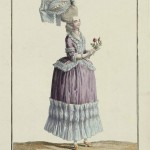

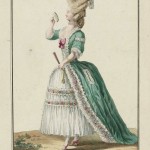
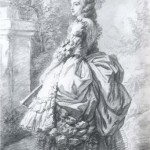
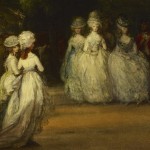

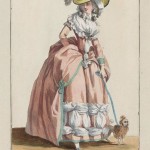
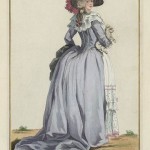

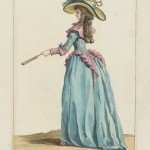
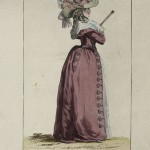
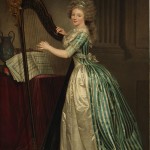
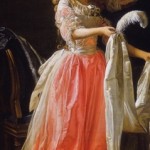




































Wonderful! So nice to see a run down of so many different shapes on different sized bodies.
What a fabulous article! It s great to see so many of the different shapes compared to each other – thanks so much for sharing!
Superb! Very difficult to get this shape correct I’ve found, and very interesting reading. You have inspired me to have another go!
ACK! I had forgotten how dramatic my scoliosis looks in these photos, especially in the back views!
But besides that, thanks for putting this up here for all to read! I’m STILL hunting for the right skirt shape for the late 1770s-early 1780s. Everything I come up with somehow looks off in one way or another. Experimentation is key!
What a great article, I love the care you take with the details!
I am thinking of trying to make #3, and I am wondering if making it shorter, with fewer rows of squares, would make it more comfortable to wear. Would you ever incorporate more than one of these for the same garment?
Hope to see you soon!
Rita
Hey Rita! I wouldn’t worry about #3 being uncomfortable to wear — it’s basically like sitting on a nice soft pillow. Yes, I do wonder about combining some of them, like the bouffante for levites (#4) with another of the pad shapes. I also think adding a quilted petticoat would DEFINITELY complete the silhouette, but that’s not always comfortable if it’s warm…
Fantastic article! Thank you!
So I followed the link for the early 19th century bustle from 6. The Source – Extant Garments, 18th-early 19th c. (Metropolitan Museum of Art) and apparently the date has been changed to 1850-1875.
http://www.metmuseum.org/Collections/search-the-collections/80006818
Interesting! That may help clarify that one!
wow! this post is awsome! I’m a fashion design student and look for information for my fashion history essay 😮 It would helps me lots! I defo write a references, thank u 🙂 🙂
Which one of these fits better for a robe a l’anglaise?
Kate: it depends on which era you want to do! Personally, I like #3 for 1770s-1785/6ish, and then #7 for late 1780s/early 1790s.
Oh, thanks a lot for the answer!!
Thank you for the comparisons– and the citations! Your review is super-useful in helping me pick and choose which under-shapes to make to use with gowns that can be “tweaked” to be used for different time periods! I’m saving your link to my references Pinterest board, because I WILL be coming back again!
This is extremely helpful! I will definitely be using this page to determine exactly what sort of understructure I need for my 1785-ish dress. Thank you for putting all of this together!
This was a fascinating article. What a lot of work! I really enjoyed it. I’m trying my first 18th century dress, and I really appreciate the info. Thanks so much!
These were helpful but they were stolen from women naturally shaped the way these bums appear to be.
The skirt the ladies are wearing, was it hemmed to make the hem line even when the pads were worn or was it hemmed straight parallel to the waist with out pads?
I have a question. I have been doing some research on late 17th and early 18th century French corsetry. Somewhere I read about and saw an image of pre-bustle bum enhancement. It was a loop fastened at the shoulders hanging down to the buttocks at which point an under-dress was draped through the loop. This then provided extra padding beneath the back side of the lady’s dress or skirt. Do you know anything about this method, and if so, can you give me a refernce. Thanx for the wonderful and useful information in the article and for any help you may be able to give.
Stephen Gottesman
What is/are the origins of bum padding in European fashion? How did this look become desirable? What or who was it based on?
Thanks
Thank you so much for all of your work and expertise! I am going to be doing costumes for “the scarlet pimpernel’ and have been madly studying late 18th century clothing in an effort to do a decent job. Sincerely appreciate the time you have taken to share your knowledge!
This paragraph is found just above the 1st reproduction:
“In each of the silhouette photographs, the models are wearing the rump, an under-petticoat, and a dress petticoat. The petticoats were not made to be worn over these specific rump shapes, so the hemlines are often wonky.”
A petticote made to be worn over supports is hemmed on the grain and leveled at the waist. It can be done using measurements taken from the floor to waist up over the support at front, sides, and back. Deduct how many inches you want the hem up from the floor. There is a very good tutorial by Koshka the Cat.
http://www.koshka-the-cat.com/18c_petticoat.html
Thanks for taking the time to test the different silhouettes and creating this resource; I am definitely bookmarking this page!